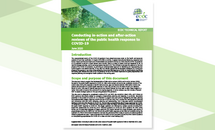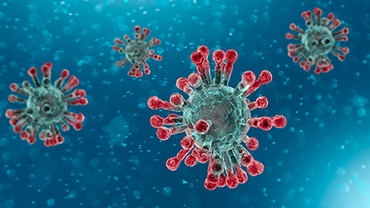Conducting after-action reviews of the public health response to COVID-19: update
This document aims to support countries in designing after-action reviews (AARs) of the public health response to COVID-19. It has been designed to draw upon pre-existing ECDC guidance [1-4] and follows a methodological approach combining interactive workshops and interviews. The Annexes feature practical implementation tools.
Executive summary
The production of this report involved a series of online meetings with ECDC National Focal Points for Preparedness and Response. An online consultation took place on 6 July 2021, and two online pilot workshops to assess an earlier version of the methods presented in this report took place on 14 and 28 March 2022.
This document updates and builds upon previous ECDC guidance focused on conducting AARs focused on COVID-19. In the early phases of the COVID-19 pandemic, in June 2020, ECDC published guidance on conducting in- action reviews (IARs) and AARs of the public health response to COVID-19. In recognition of the increased need to conduct IARs during the protracted response to COVID-19, ECDC published a detailed one-day IAR protocol in March 2021. Additionally, in recognition of the importance of the topic, ECDC published a protocol for conducting AARs focused on evidence-based decision-making in September 2021. Building on each of these documents, this report provides further details and tools (see Annexes) to support the implementation of robust AARs focused on the response to COVID-19.
As explained in our previous guidance, an AAR seeks to review actions undertaken during the response to an event of public health concern by objectively observing, analysing gaps and/or best practices and identifying areas for improvement in preparedness and response activities. An AAR does not seek to apportion blame but rather to identify learning opportunities and to contribute to the cycle of continuous quality improvement in emergency preparedness and response planning. AARs typically seek to address five common questions:
- What happened during the response (and what was supposed to have happened)?
- Why did it happen?
- What can be learned?
- What should change?
- Have changes taken place?
The approach we advocate here identifies the possibility of combining prioritised response areas into modules. The COVID-19 pandemic has been an unprecedented event in size, scope, and duration. Due to this, the design of an AAR for this event may differ from smaller events, as it will not be feasible to address all aspects of response in one AAR. It may be beneficial, therefore, to conduct multiple AARs to focus on different areas of the public health response and/or different jurisdictional levels.
The guidance presented here adheres to and draws upon previously identified best practices and covers all the phases of conducting an AAR, including dissemination strategies. In addition, this document has been informed by feedback from two online consultations about this topic among ECDC National Focal Points for Preparedness and Response.
The protocol and methodology proposed are fully adaptable across national and sub-national contexts The target audience of this protocol is public health experts from EU/EEA Member States, EU candidate and potential candidate countries, and European Neighbourhood Policy countries.
Download







